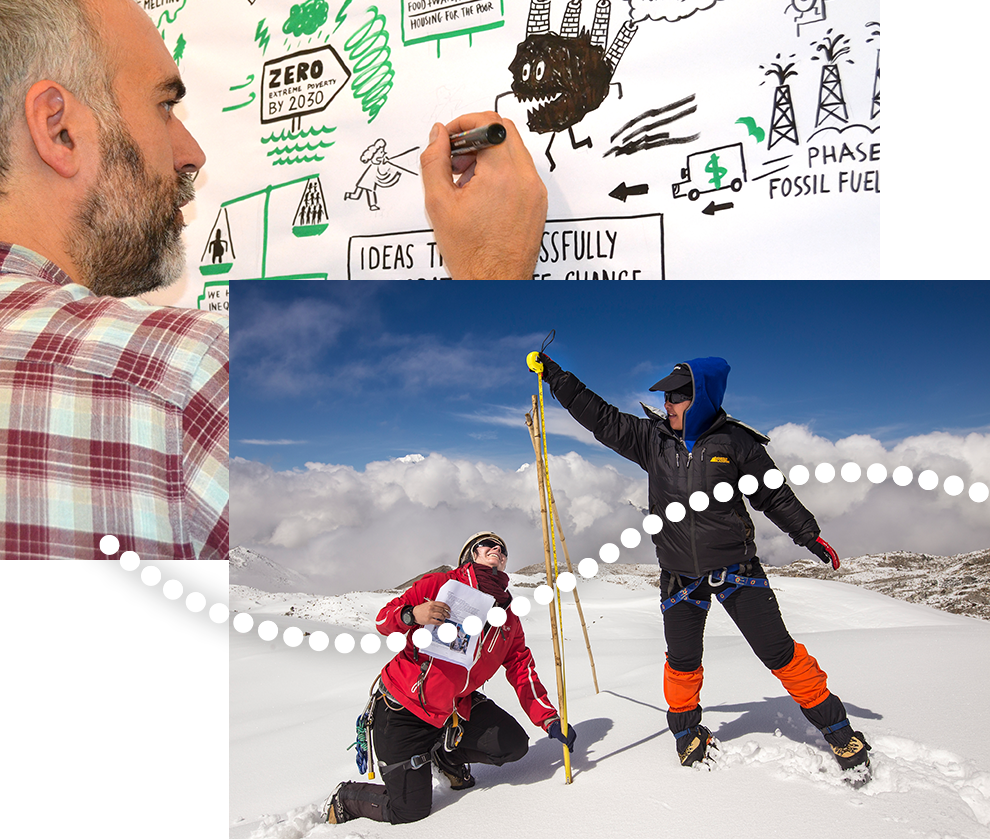Alignment to Advance Climate-Resilient Development: Colombia Case Study

Introduction
The achievement of climate-resilient development is at the forefront of Colombia’s response to climate change. Given the increasing importance of coherent and effective multi-level strategies to respond to the challenges—and opportunities—posed by climate change, ensuring alignment between various policy processes is more relevant than ever before. Colombia adopted the 2030 Agenda for Sustainable Development at Rio+20, which was followed by the adoption of the Sendai Framework for Disaster Risk Reduction in 2015 and the ratification of the Paris Agreement in 2018, setting a strong basis for subsequent alignment efforts.
The related national-level policy documents identify strong synergies between the different agendas, which creates significant opportunities for alignment. The Government of Colombia has also formulated specific laws and policies to implement each agenda in the country that are accompanied by cross-ministerial coordination mechanisms to mainstream these processes into sectoral and local policies.
This case study analyzes the status of the alignment between the Paris Agreement, the Sendai Framework for Disaster Risk Reduction, and the 2030 Agenda for Sustainable Development in Colombia, and identifies key challenges, opportunities and next steps suggested to advance the process of alignment in the country. It provides an overview of the socioeconomic development and climate change context of the country, including its vulnerability to climate change and ongoing policy actions, followed by a description of the main coordination mechanisms and policies under each agenda. The last sections present key synergies between them and entry points for articulation, and proposes next steps to pursue further alignment in Colombia.
*Download the full case study from the right-hand column. A short overview of the publication is provided below. A full version in French and Spanish is also available on the NAP Global Network website.
Synergies and Linkages Among the Policy Processes in Colombia
The following are important achievements for Colombia to build upon toward further alignment at both the policy and the practice levels:
The National Adaptation Plan (NAP) acknowledges that disaster risk management (DRM) and climate change adaptation are complementary strategies and that both should be promoted in order to achieve effective development.The conceptual and methodological phase of Colombia’s NAP recognizes that climate change increases the uncertainty and complexity of disaster risk management and emergency response. Adaptation and DRM are seen as two sides of the same coin, and therefore improving the ability to manage disaster risks will enable better adaptive responses to climatic impacts in the short, medium and long terms.
The National Plan for Disaster Risk Management includes a strategy for articulation with the National Development Plan, with sectoral policies and with the NAP.As part of the strategies proposed to achieve its objectives, the Plan identifies the need to improve information management from an inter-sectoral, inter-institutional and interdisciplinary perspective, to foster action-oriented research considering both DRM and climate change adaptation knowledge and practices, and to articulate DRM and adaptation measures as part of sectoral policies and other national plans.
Colombia’s Nationally Determined Contribution (NDC)-related information on adaptation has been closely aligned with the country’s NAP.The NAP serves as the basis of the adaptation information of Colombia’s NDC. The adaptation component indicates a commitment to focus the country’s efforts on the development of national resilience in line with international agreements. The NDC includes the development of (adaptation) action plans by territories and sectors, monitoring and evaluation (M&E) systems to track and assess progress, as well as the implementation of sustainable management of water resources.
The adaptation goals of the NDC are integrated into the Strategy for the Implementation of the Sustainable Development Goals (SDGs) in Colombia.In order to formulate the policy document for the implementation of the 2030 Agenda in Colombia, the High-Level Commission of the SDGs held consultations with different economic sectors and with civil society seeking alignment with the National Development Plan 2014–2018, the Green Growth Strategy and national-level efforts identified under the Paris Agreement. Hence, the document recognizes the mitigation and adaptation goals of the NDC to implement Goal No. 13 of the 2030 Agenda, identifying thematic linkages between the two global agendas.
The alignment between agendas is reflected in the National Development Plan 2018–2022.This planning instrument translated the NDC and the SDG Policy Document targets into government goals by establishing strategies and quantifiable indicators to contribute to the achievement of the 17 SDGs. The plan includes an action line on achieving resilience through knowledge and prevention for disaster risk management and climate change adaptation.
Entry Points and Opportunities for Enhanced Alignment
Current efforts to identify synergies among the different policy processes should aim to improve the coherence of national policies and maximize the efficiency and effectiveness of investments to promote sustainable development. There are a number of entry points to achieve a more strategic approach to alignment in the country:
- Generate a formal coordination mechanism between the national climate change system (SISCLIMA) and the High-Level Commission for the SDGs.Both the Cross-Sectoral Commission on Climate Change (CICC) and the High-Level Commission for the SDGs are carrying out similar processes at the national and sub-national levels of government, such as integration in national and sub-national planning processes, capacity building at the local level, and monitoring of adaptation goals. However, currently no formal coordination mechanisms exist between the national climate change system and High-Level Commission.
- Foster a permanent dialogue between the National Disaster Risk Management System and the NAP process as complementary approaches to sustainable development.The National System for Disaster Risk Management oversees the implementation of the National Plan for Disaster Risk Management, while the National Planning Department (DNP) is responsible for the NAP and for the SDG implementation Strategy in Colombia. While the NAP acknowledges the importance of integrating disaster risk reduction and climate adaptation, and the SDGs acknowledge the importance of institutional coordination, there are no formal coordination mechanisms in place to ensure a more permanent dialogue and information-sharing among them.
- Coordination of national priorities and sub-national implementation.While the national processes under the Paris Agreement, the Sendai Framework and the 2030 Agenda are driven by national institutions, the accomplishment of adaptation objectives requires the active involvement of a variety of stakeholders at both the national and the sub-national levels. This implies a strong role for Colombia’s regions and territories in the achievement of adaptation goals. Coordination among leading national institutions and regional governments (including the use of integrated planning mechanisms to streamline processes for accessing funds for implementation) is key to advancing alignment in Colombia.
- Establish a clear mandate to seek alignment.A key contributing factor to achieve systematic alignment is a clear mandate for alignment, articulated at a high level of government and supported by adequate political will.
Lessons Learnt
Key Messages
- Significant progress has been made on the alignment of Colombia’s NDC, NAP process and its strategy for implementing the SDGs, with specific links and synergies identified in the respective policy documents.
- The emerging policy processes make reference to one another, and recognize related objectives and strategies, allowing the national government to send coherent adaptation messages.
- Important opportunities exist for Colombia to continue moving toward strategic alignment by taking advantage of existing institutional coordination mechanisms that bring together a consistent pool of stakeholders involved in the three policy processes.
- Among the entry points to strengthen alignment are (a) the generation of information-sharing tools among coordination mechanisms, (b) fostering capacities at the sub-national and local levels in order to ensure that alignment is actionable, and (c) deepening the articulation of adaptation tracking, M&E, to ensure robust reporting and learning across levels.
Conclusion
This analysis of the linkages and synergies that exist between the 2030 Agenda for Sustainable Development, the Paris Agreement and the Sendai Framework for Disaster Risk Reduction, suggests that there is a solid basis to continue advancing the alignment process in Colombia. Going forward, efforts on policy alignment will need to be accompanied by the establishment of new cross-sectoral partnerships, flexible mechanisms for information sharing, access to innovative research and approaches to secure the human, technical and financial capacity needed to articulate policy goals, adaptation and risk reduction practice.
In addition to deepening existing synergies and exploring the entry points suggested above, among others, further efforts should be made regarding documenting, sharing and extracting lessons from the alignment process across policy agendas and at multiple levels. Next steps should also include a continuous exchange of knowledge and best practices with other countries that are fostering alignment to achieve a resilient future.
Alignment to Advance Climate-Resilient Development | Country case study: Colombia
134 Downloads- Alignment to Advance Climate-Resilient Development
- Alignment to Advance Climate-Resilient Development | Getting Started on Alignment
- Alignment to Advance Climate-Resilient Development | Country Perspectives on Alignment
- NAP Process and NDCs
- Using NDCs and NAPs to Advance Climate-Resilient Development
- Alignment to Advance Climate-Resilient Development: Sri Lanka Case Study
- Alignment to Advance Climate-Resilient Development: Kenya Case Study
- Cruz, L.C. (2019). Colombia’s progress in developing a national monitoring and evaluation system for climate change adaptation
- Departamento Nacional de Planeación. (2016). National Adaptation Plan: Strategic Action Lines for Adaptation to Climate Change
- Departamento Nacional de Planeación. (2018) Strategy for the implementation of the SDG in Colombia
- Government of Colombia. (2015). Contribución Prevista y Determinada a Nivel Nacional iNDC.
- Ministerio de Ambiente y Desarrollo Sostenible (MADS). (2016). El Acuerdo de París: así actuará Colombia ...

Comments
There is no contentYou must be logged in to reply.